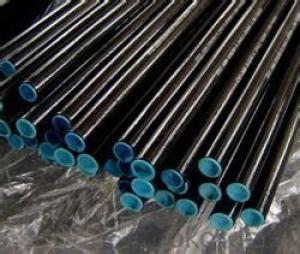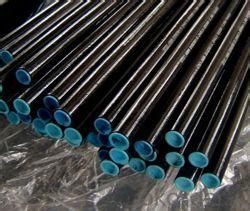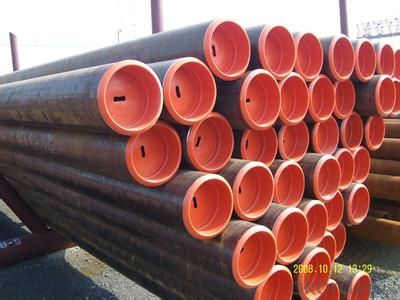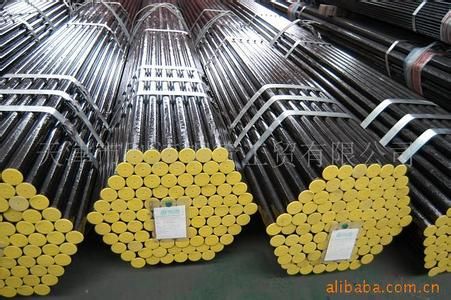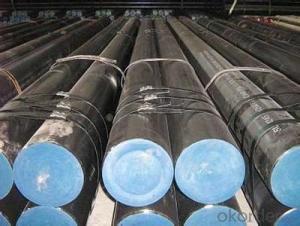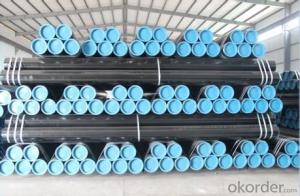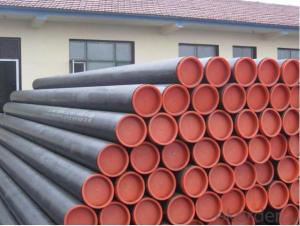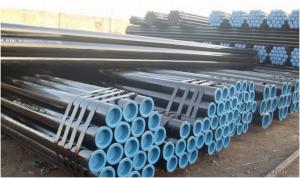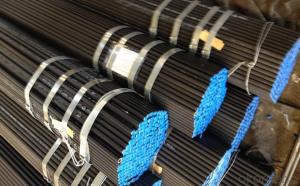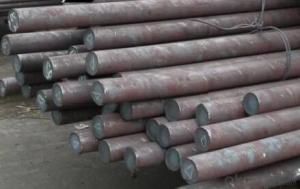Carbon seamless steel tube ASTM A 106 B/ ASTM A5
- Loading Port:
- Tianjin
- Payment Terms:
- TT or LC
- Min Order Qty:
- 25 m.t.
- Supply Capability:
- 6000 m.t./month
OKorder Service Pledge
OKorder Financial Service
You Might Also Like
1、Structure of Carbon seamless steel tube ASTM A 106 B/ ASTM A5:
Seamless pipe is formed by drawing a solid billet over a piercing rod to create the hollow shell. As the manufacturing process does not include any welding, seamless pipes are perceived to be stronger and more reliable. Historically seamless pipe was regarded as withstanding pressure better than other types, and was often more easily available than welded pipe.
2、Main Features of Carbon seamless steel tube ASTM A 106 B/ ASTM A5:
• High manufacturing accuracy
• High strength
• Small inertia resistance
• Strong heat dissipation ability
• Good visual effect
• Reasonable price
3、Carbon seamless steel tube ASTM A 106 B/ ASTM A5 Specification:
Standard | GB, DIN, ASTM ASTM A106-2006, ASTM A53-2007 |
Grade | 10#-45#, 16Mn 10#, 20#, 45#, 16Mn |
Thickness | 8 - 33 mm |
Section Shape | Round |
Outer Diameter | 133 - 219 mm |
Place of Origin | Shandong, China (Mainland) |
Secondary Or Not | Non-secondary |
Application | Hydraulic Pipe |
Technique | Cold Drawn |
Certification | API |
Surface Treatment | factory state or painted black |
Special Pipe | API Pipe |
Alloy Or Not | Non-alloy |
Length | 5-12M |
Outer Diameter | 21.3-610mm |
Grade | 20#, 45#, Q345, API J55, API K55, API L80, API N80, API P110, A53B |
Standard | ASME, ASTM |
1) Material:20#(ASTM A 106/A53 GRB.API5LGRB,GB),45#,16Mn,10#.
2) Specification range:OD:21.3-610mm,WT:6-70mm,length:6-12m or according to the requirement of clients.
3) Excutive standards:GB,ASME API5L.ASTM A 106/A53,Despite of the above standards,we can also supply seamless steel pipe with standard of DIN,JIS,and so on,and also develop new products according to the requirements of our clients!
4) Surface:black lacquered,varnish coating or galvanized.
5) Ends:Beveled or square cut,plastic capped,painted.
6) Packing:bundles wrapped with strong steel strip,seaworthy packing.
4、Packaging & Delivery
Packaging Details: | seaworthy package,bundles wrapped with strong steel strip |
Delivery Detail: | 15-30days after received 30%TT |
5、FAQ of Carbon seamless steel tube ASTM A 106 B/ ASTM A5:
①How is the quality of your products?
Our products are manufactured strictly according to national and internaional standard, and we take a test
on every pipe before delivered out. If you want see our quality certifications and all kinds of testing report, please just ask us for it.
Guaranteed: If products’ quality don’t accord to discription as we give or the promise before you place order, we promise 100% refund.
②How about price?
Yes, we are factory and be able to give you lowest price below market one, and we have a policy that “ for saving time and absolutely honest business attitude, we quote as lowest as possible for any customer, and discount can be given according to quantity”,if you like bargain and factory price is not low enough as you think, just don’t waste your time.Please trust the quotation we would give you, it is professional one.
③Why should you chose us?
Chose happens because of quality, then price, We can give you both.Additionally, we can also offer professional products inquiry, products knowledge train(for agents), smooth goods delivery, exellent customer solution proposals.Our service formula: good quality+good price+good service=customer’s trust
SGS test is available, customer inspection before shipping is welcome, third party inspection is no problem.
6、Carbon seamless steel tube ASTM A 106 B/ ASTM A5 Images:
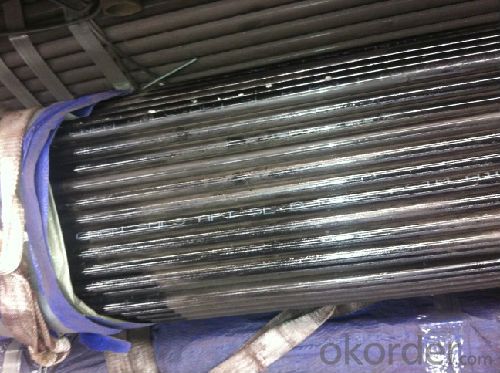
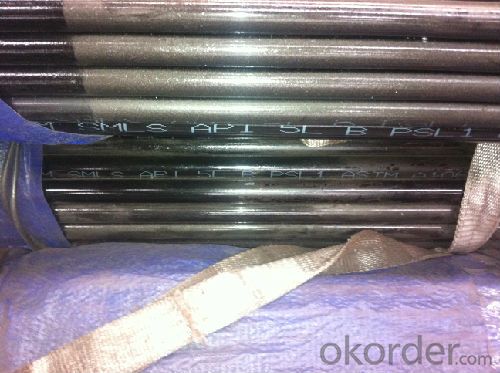
- Q: Does the seamless steel pipe need rust removal?
- Spray (throw) shoot derusting by the high-power motor to drive the spray shot (impeller) blade rotating speed, the steel grit, steel shot, iron wire, minerals and other abrasive jet for 20# seamless steel tube surface under the action of centrifugal force (left) radiation treatment, not only can completely remove the dirt and rust, oxide, and the role of 20# seamless steel in abrasive blast and friction force, can achieve the required uniform roughness.Not only can the physical adsorption effect on the surface of the pipe be increased, but also the mechanical adhesion of the anticorrosive layer to the pipe surface can be enhanced. Therefore, spraying (throwing) shot derusting is an ideal method of rust prevention for pipeline corrosion protection. Generally speaking, shot peening (sand) derusting is mainly used in the inner surface treatment of tubes, shot blasting (sand) derusting is mainly used for the outer surface treatment of tubes.
- Q: When can I use the PVC pipe and when to use the galvanized pipe?
- Galvanized pipes are generally used outside the drying environment or building blocks, and PVC is mainly used for pre embedding in walls or humid environments. If in the ceiling ceiling, below the roof, you need to use galvanized pipe, in the floor below, on the ground you need to use PVC.
- Q: How are steel pipes used in the construction of gas distribution networks?
- Steel pipes are commonly used in the construction of gas distribution networks due to their durability, strength, and resistance to corrosion. These pipes are installed underground to transport natural gas from the source to various distribution points. They are used to create a reliable and efficient network that delivers gas safely to homes, businesses, and industries.
- Q: What are the different types of steel pipe connections for oil and gas pipelines?
- The different types of steel pipe connections for oil and gas pipelines include threaded connections, welded connections, and flanged connections. Threaded connections involve screwing the pipes together using a threaded end, which ensures a secure fit. Welded connections involve permanently joining the pipes together using welding techniques such as butt welding or socket welding. Flanged connections involve attaching flanges to the ends of the pipes and bolting them together, providing a strong and leak-proof connection.
- Q: How are steel pipes coated for insulation purposes?
- Steel pipes are commonly coated for insulation purposes using various methods and materials. One common method is the application of a thermal insulation coating. This coating is usually a high-performance polymer or epoxy-based material that is applied to the surface of the steel pipe. Before the coating is applied, the steel pipe is usually cleaned thoroughly to remove any dirt, grease, or rust that may be present on its surface. This is typically done through a process called abrasive blasting, where small particles are propelled at high speed to remove contaminants and create a clean, rough surface for the coating to adhere to. Once the surface is prepared, the thermal insulation coating is applied using different techniques such as spraying, brushing, or rolling. The coating is carefully applied in multiple layers to ensure proper coverage and thickness. This helps to create a barrier between the steel pipe and the external environment, preventing heat transfer and minimizing energy loss. In addition to thermal insulation coatings, steel pipes can also be coated with materials such as polyurethane foam or mineral wool. These materials provide excellent thermal insulation properties and are often used in applications where high-temperature resistance is required. Overall, steel pipes are coated for insulation purposes through a combination of surface preparation and the application of specialized coatings. These coatings help to reduce heat loss, increase energy efficiency, and protect the steel pipe from corrosion and other environmental factors.
- Q: Are steel pipes resistant to UV radiation?
- Generally, steel pipes have resistance to UV radiation. UV radiation is known to cause damage to materials over time, resulting in fading, discoloration, and degradation. However, steel pipes usually have protective layers, such as paint or galvanization, that help shield them from UV radiation. These coatings act as a barrier, preventing direct exposure of the steel to UV rays and minimizing potential damage. Furthermore, steel's inherent properties, including strength and durability, make it less susceptible to the effects of UV radiation compared to materials like plastics or rubber. Nevertheless, it is important to note that prolonged exposure to intense UV radiation can still have some impact on steel pipes, such as slight discoloration or surface degradation. To ensure the continued performance and longevity of steel pipes in outdoor or UV-exposed environments, regular maintenance and inspection are recommended.
- Q: Can steel pipes be used for transporting drinking water?
- Yes, steel pipes can be used for transporting drinking water. Steel pipes are commonly used in water distribution systems and have been used for many years. They are known for their durability, strength, and resistance to corrosion. However, it is important to ensure that the steel pipes used for transporting drinking water are properly coated or lined to prevent any potential contamination from the metal. Additionally, regular inspections and maintenance should be carried out to ensure the integrity of the pipes and to prevent any leaks or breaks that could compromise the quality of the water.
- Q: Can steel pipes be used for conveying abrasive slurries?
- Indeed, abrasive slurries can be effectively conveyed through steel pipes. The remarkable durability and strength of steel pipes render them highly suitable for the transportation of abrasive substances like slurries. Nevertheless, to guarantee prolonged service life and avert excessive deterioration, it is crucial to carefully choose the right grade of steel and take into account factors such as pipe thickness, lining choices, and flow velocity. Furthermore, the implementation of adequate maintenance and inspection protocols can play a pivotal role in promptly identifying and resolving any wear or corrosion issues that may arise with time.
- Q: What are the future trends in steel pipe manufacturing?
- Some of the future trends in steel pipe manufacturing include the use of advanced automation and robotics, the development of high-strength and lightweight steel materials, the implementation of sustainable and environmentally friendly manufacturing processes, and the integration of digital technologies for improved quality control and efficiency. Additionally, there is a growing focus on developing steel pipes with enhanced corrosion resistance and durability to meet the demands of various industries such as oil and gas, construction, and automotive.
- Q: What are the common maintenance practices for steel pipes?
- Steel pipes require regular inspections, cleaning, and corrosion prevention as part of their maintenance. It is crucial to conduct inspections frequently to detect any signs of damage or wear. These inspections can involve visual assessments and non-destructive testing methods like ultrasonic or magnetic particle inspection. Scheduling inspections ensures early detection of issues, allowing for prompt resolution. Cleaning is also a vital maintenance practice for steel pipes. It involves the removal of dirt, debris, and scale that may accumulate on both the inside and outside of the pipes. Regular cleaning prevents blockages, enhances flow efficiency, and reduces the risk of corrosion. Corrosion prevention plays a significant role in maintaining steel pipes. Different methods, such as applying protective coatings, utilizing cathodic protection systems, or implementing corrosion inhibitors, can be employed to safeguard the pipes. These measures extend the pipes' lifespan and preserve their structural integrity over time. Additional maintenance practices may include repairing or replacing damaged sections of the pipes, maintaining proper insulation to prevent heat loss or gain, and monitoring the pipes for any signs of leakage or pressure drops. In summary, regular inspections, cleaning, and corrosion prevention are vital maintenance practices for steel pipes. Implementing these practices prolongs the pipes' lifespan and allows for the identification and resolution of potential issues before they cause significant damage or disruptions.
Send your message to us
Carbon seamless steel tube ASTM A 106 B/ ASTM A5
- Loading Port:
- Tianjin
- Payment Terms:
- TT or LC
- Min Order Qty:
- 25 m.t.
- Supply Capability:
- 6000 m.t./month
OKorder Service Pledge
OKorder Financial Service
Similar products
Hot products
Hot Searches
Related keywords
